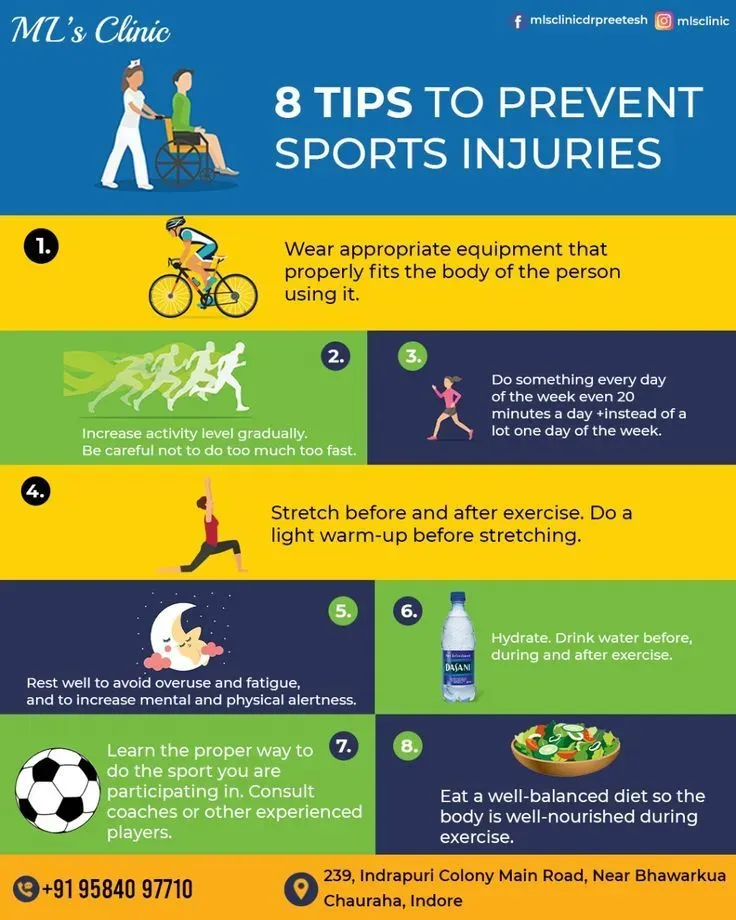Sports injury prevention is a proactive, evidence-based approach that blends science, training, and daily habits. Athletes at all levels benefit when preventing sports injuries becomes a routine part of practice. You’ll find injury prevention tips for athletes that emphasize practical strategies to reduce common risks while maintaining performance. Key elements include a proper warm-up and cooldown, smart load management in sports, adequate sleep, and progressive strength work. By treating prevention as a core habit rather than an afterthought, you can stay healthier, train more consistently, and extend your season.
From a different angle, injury risk reduction in sport can be framed as risk management and performance resilience. These LSI-aligned terms connect to practical ideas like optimized training load, neuromuscular preparation, and recovery protocols that support long-term participation. Think of it as a comprehensive program—conditioning, movement quality, and restorative practices—designed to keep athletes on the field and performing at their best.
Sports Injury Prevention: A Science-Backed, Practical Plan
Sports injury prevention is not a matter of luck; it’s a deliberate, evidence-based approach that blends science, training, and daily habits. Framed by four pillars—preparation, strength and conditioning, movement quality, and recovery—this plan emphasizes prevention as a repeatable routine rather than a one-off fix. By treating prevention as integral to practice, athletes at all levels can reduce downtime and extend meaningful seasons.
To put this into action, adopt practical steps that align with injury prevention tips for athletes. Start with a four-week cycle that emphasizes a consistent warm-up, a balanced strength routine, technique work, and deliberate recovery. When prevention becomes a daily discipline, you’re better equipped to handle fatigue, adapt to training loads, and stay on the field longer. This approach also supports preventing sports injuries by addressing both acute events and overuse patterns before they become entrenched.
Dynamic Warm-Up and Activation: The First Line of Defense Against Injury
A dynamic warm-up is more than a quick jog; it’s a structured 10–15 minute sequence designed to raise core temperature, mobilize joints, and activate key muscles used in your sport. By integrating general aerobic prep, dynamic mobility, activation drills, and movement prep, you prime the body for safe performance and sharper neuromuscular control.
Incorporating proper warm-up and cooldown routines reduces the incidence of common injuries such as ankle sprains and hamstring strains. This pillar of injury prevention is easy to implement across training days, serving as a reliable foundation for movement quality, load management, and sport-specific work. When athletes consistently execute a well-planned warm-up, they set a safety baseline that supports more aggressive training later in practice.
Strength and Conditioning for Resilience: Progressive Overload and Tissue Tolerance
Strength training is about balanced function and tissue tolerance, not vanity numbers. Focus areas include lower-body strength for hips, knees, and ankles; posterior chain and hip stability; calf and ankle work; and core control. A well-rounded program builds resilience to tolerate fatigue and adapt to sport-specific demands, reducing the risk of strains and ligament injuries.
Progressive overload—carefully increasing load and complexity while monitoring fatigue—drives durable adaptations. Eccentric hamstring loading and knee-stability work are particularly effective at preventing common injuries in many sports. By tying strength work to injury prevention in sports, you create a robust tissue tolerance that supports performance when fatigue creeps in and volume increases.
Movement Quality and Technique: Safe Mechanics for Longevity
Movement quality is a major, modifiable component of injury risk. Emphasize safe landing mechanics, efficient deceleration, and sound cutting technique. Poor landing patterns, knee valgus during change of direction, and lapses in trunk control are common risk points that can be mitigated with targeted drills and coaching.
Integrate sport-specific technique work into regular practice, reinforcing knee alignment over the toes, hip hinge patterns, and controlled decelerations. Regular cooldown-focused drills that challenge balance and stabilization help sustain safer mechanics when fatigue sets in, ensuring that technique remains strong even in the latter parts of a game or practice.
Recovery, Sleep, and Nutrition: The Recovery Pillar of Injury Prevention
Recovery is the bridge between workouts and performance. Adequate sleep (roughly 7–9 hours for most adults), balanced nutrition, and proper hydration support tissue repair, immune function, and readiness. Recovery strategies include post-workout refueling, mobility work, soft-tissue work, and regular deload weeks during heavy training blocks.
Load management in sports is about matching training stimulus with capacity. By tracking training load (volume × intensity), fatigue, and wellness indicators, athletes can adjust sessions to avoid overreaching. Simple tools like RPE scales and wellness questionnaires help identify when to back off, reducing injury risk and promoting sustainable progress.
Sport-Specific Strategies and Monitoring: Personalizing Prevention Across Athletes
Injury prevention benefits from tailoring strategies to sport demands. Runners might emphasize gradual mileage progression, strides, and conditioning for shin and calf health, while ball-and-stick sports prioritize ankle stability and multi-directional control. Swimmers benefit from shoulder stability and scapular mechanics. Personalized plans consider age, history, and the unique stresses of each sport.
Effective prevention relies on ongoing monitoring and collaboration among coaches, medical staff, and athletes. Use simple tools like training-load tracking, fatigue logs, and regular check-ins to adjust programs. Injury prevention tips for athletes become more actionable when plans are data-informed and when athletes openly report pain or fatigue, enabling timely rehabilitation and safer returns to play.
Frequently Asked Questions
What is sports injury prevention and how does it benefit athletes?
Sports injury prevention is a proactive, evidence-based approach built on four pillars: preparation (dynamic warm-ups and activation), strength and conditioning, movement quality, and recovery. By following these pillars, athletes reduce common injuries, train more consistently, and extend their competitive seasons.
How does proper warm-up and cooldown contribute to sports injury prevention?
Proper warm-up and cooldown are core to injury prevention. A 10–15 minute dynamic warm-up raises core temperature, mobilizes joints, and activates key muscles, while a structured cooldown with mobility work and light activity supports recovery and reduces soreness, lowering the risk of injuries like strains or sprains.
Why is load management in sports critical for preventing injuries?
Load management in sports balances training stress with an athlete’s capacity. Track training load (volume × intensity), monitor fatigue, and adjust sessions when signs of overreaching appear. Using tools like RPE scales or wellness checks helps prevent injuries by backing off before tissue limits are exceeded.
What injury prevention tips for athletes can be implemented this week?
Try these injury prevention tips for athletes this week: start every practice with a 10–15 minute dynamic warm-up; schedule two primary strength days focusing on hips, glutes, quads, hamstrings, and core; add biomechanical drills for landing and deceleration; keep a daily recovery log; ensure footwear matches your sport and foot type.
Which training methods focus on movement quality and technique to prevent sports injuries?
Focus on movement quality and technique to prevent sports injuries by coaching safe landing mechanics, deceleration control, and knee alignment. Integrate sport-specific drills that reinforce hip hinges and single-leg stability into practice and cooldowns for consistent, safer mechanics, especially when fatigued.
How can you tailor sports injury prevention to your sport and injury history?
Tailor sports injury prevention by adapting strategies to your sport, age, and injury history. Emphasize sport-specific conditioning, progressive load increases, and collaboration with coaches and medical staff. Regular check-ins, clear return-to-play protocols, and individualized adjustments help sustain durability and performance.
| Topic | Focus | Key Points / Examples |
|---|---|---|
| Pillar 1: Dynamic Warm-Up and Activation | Purpose, duration, and components | 10–15 minute warm-up; general aerobic prep; dynamic mobility for hips, ankles, shoulders, and thoracic spine; activation drills for glutes, quadriceps, hamstrings, and core; movement prep mirroring sport actions; reduces common injuries by improving muscle readiness and joint safety. |
| Pillar 2: Strength and Conditioning for Resilience | Key components and approach | Lower-body strength; posterior chain and hip stability; calf and ankle work; core control; Progressive overload with fatigue monitoring; eccentric loading for hamstrings and knee stability; builds tissue tolerance and motor control. |
| Pillar 3: Movement Quality and Technique | Technique reduces injury risk | Improve landing mechanics, deceleration control, and knee alignment; drills emphasize knee alignment over toes, hip hinge, and controlled decelerations; include single-leg balance and stabilization drills to reinforce safe mechanics when tired. |
| Pillar 4: Recovery, Sleep, and Nutrition | Recovery fundamentals | Recovery includes adequate sleep (7–9 hours), balanced nutrition and hydration, post-workout refueling within 30–60 minutes, soft-tissue work, mobility, and active recovery; deload weeks and load management; monitor fatigue and adjust load using RPE or wellness checks. |
| Practical Tips | Weekly actions | Start every practice with a 10–15 minute dynamic warm-up; schedule two primary strength days per week focusing on hips, glutes, quads, hamstrings, and core; include one or two biomechanical drills per session for landing and deceleration; keep a daily recovery log; ensure proper gear and footwear. |
| Common Myths Debunked | Myth overview | More is not always better; stretching alone does not prevent injuries; pain does not automatically mean injury; address nagging issues early. |
| Practical Plan (4-Week Cycle) | Plan overview | Put together a four-week cycle: Week 1–2 establish warm-up and baseline strength; Week 3–4 progress by increasing load or drill complexity; repeat with gradual intensity; use a weekly scaffold (Mon–Sun) with focused daily activities. |
| Coaching, Medical Staff, and Athlete Collaboration | Team-based prevention | Injury prevention thrives on teamwork: coaches manage load, medical staff monitor injuries and rehab, and athletes communicate fatigue honestly; cultivate a safety-first culture; regular check-ins, return-to-play protocols, and individualized adjustments are essential. |
Summary
Sports injury prevention is a proactive, evidence-informed process that blends dynamic warm-ups, strength and conditioning, movement quality, and recovery into daily practice. When applied consistently and tailored to sport demands, history, and training load, these pillars help athletes stay on the field longer, train more reliably, and perform with greater confidence. Through teamwork among coaches, medical staff, and athletes, injury risk declines and sustainable performance improves across seasons.



